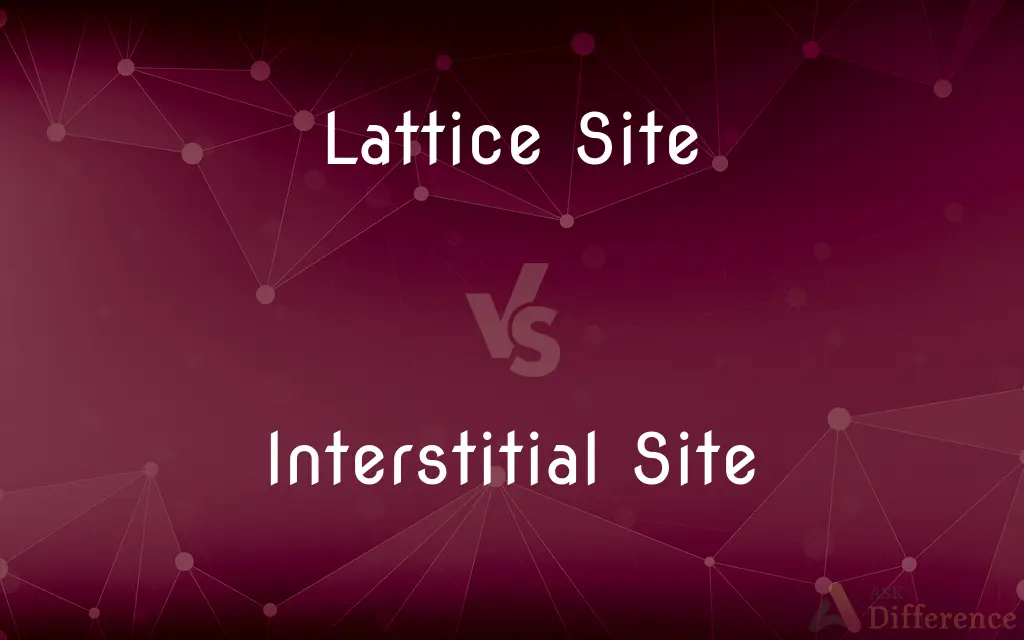Lattice Site vs. Interstitial Site — What's the Difference?
By Tayyaba Rehman — Published on November 17, 2023
Lattice sites are regular positions in a crystal where atoms or ions reside, while interstitial sites are spaces between these atoms or ions where smaller atoms might fit.

Difference Between Lattice Site and Interstitial Site
Table of Contents
ADVERTISEMENT
Key Differences
Lattice sites refer to the specific, regular positions within a crystalline structure where atoms or ions are expected to be. On the contrary, interstitial sites are the spaces or gaps between these regular positions where smaller atoms or ions can occasionally be found.
In any crystalline structure, lattice sites play a fundamental role in determining the overall geometry and properties of the material. Interstitial sites, while not primary positions, can profoundly influence certain characteristics when occupied.
Lattice sites maintain the structural integrity of the crystal, ensuring its consistent and repetitive pattern. Interstitial sites offer the possibility for additional elements or impurities to be introduced without significantly disrupting the primary lattice.
The consistent and repetitive nature of lattice sites is what gives crystals their unique properties, from the angles of their facets to their refractive indices. Meanwhile, interstitial sites provide a mechanism for the introduction of dopants or impurities, which can drastically change a material's behavior, such as in semiconductors.
When discussing materials, especially metals, lattice sites typically hold the primary metal atoms. Interstitial sites might be occupied when other elements are added, leading to interstitial alloying.
ADVERTISEMENT
Comparison Chart
Position in Crystal
Regular and expected positions for atoms/ions.
Spaces or gaps between regular positions.
Role in Crystal
Maintain structural integrity.
Allow for additional elements or impurities.
Influence on Properties
Dictate primary crystalline properties.
Can change properties when occupied.
Presence
Consistently occupied in pure crystals.
Might be empty or occupied by smaller atoms/ions.
Example in Alloys
Typically hold primary metal atoms.
Might hold other elements in interstitial alloying.
Compare with Definitions
Lattice Site
The fundamental building block of a crystal's geometry.
The lattice sites in a metal determine its crystallographic planes.
Interstitial Site
Gaps within a crystalline structure where smaller atoms might fit.
In steel, carbon occupies the interstitial sites between iron atoms.
Lattice Site
The regular location where primary atoms or ions reside in a crystal.
In diamond, carbon atoms are found at each lattice site.
Interstitial Site
A space between lattice sites in a crystal.
In some metals, carbon atoms can occupy interstitial sites.
Lattice Site
The primary residence of atoms or ions in crystalline solids.
In a zinc oxide crystal, zinc and oxygen atoms alternate in their lattice sites.
Interstitial Site
Locations that can accommodate impurities or dopants in a crystal.
Silicon crystals doped with phosphorus have the dopant in interstitial sites.
Lattice Site
A consistent and repeating position in crystalline materials.
The precise angles in quartz crystals are due to the regular arrangement of atoms at lattice sites.
Interstitial Site
Secondary positions not defined by the primary crystal geometry.
The presence of hydrogen in some metals is due to its occupation of interstitial sites.
Lattice Site
A predefined position within a crystalline structure.
In a sodium chloride crystal, both sodium and chloride ions occupy lattice sites.
Interstitial Site
Spaces within a lattice that can be occupied without disrupting the primary structure.
Nitrogen atoms in titanium nitride occupy interstitial sites among titanium atoms.
Common Curiosities
Why are lattice sites important for a crystal's properties?
Lattice sites dictate the primary crystalline properties by maintaining the structural integrity and geometry of the crystal.
Can the occupation of interstitial sites change a material's properties?
Yes, when interstitial sites are occupied, especially by impurities or dopants, they can alter the material's properties.
Are lattice sites always occupied?
In pure crystals, lattice sites are consistently occupied, but defects or vacancies can occur.
Are the number of lattice sites and interstitial sites the same in a crystal?
No, the number of lattice sites is generally greater than interstitial sites, depending on the crystal structure.
Can interstitial sites be empty?
Yes, interstitial sites can be empty or occupied by smaller atoms or ions.
What are lattice sites?
Lattice sites are the regular positions in a crystal where atoms or ions reside.
How do interstitial sites differ from lattice sites?
Interstitial sites are spaces between the lattice sites where smaller atoms or ions might fit.
What happens when an element occupies an interstitial site in a metal?
It can lead to interstitial alloying, which can change the metal's characteristics.
What determines the number of interstitial sites in a crystal?
The crystal's geometry and the arrangement of atoms or ions at lattice sites determine the number and size of interstitial sites.
Can larger atoms occupy interstitial sites?
Typically, only smaller atoms or ions fit into interstitial sites without causing significant distortion.
Are vacancies considered lattice sites or interstitial sites?
Vacancies are unoccupied lattice sites. They're not considered interstitial sites.
Do all crystals have interstitial sites?
Most crystalline structures have interstitial sites, but their size and accessibility vary.
Can occupying interstitial sites make a material stronger?
Yes, in metals like steel, the presence of carbon in interstitial sites can increase its strength.
How do impurities in interstitial sites influence semiconductors?
Impurities in interstitial sites can introduce new energy levels, altering the semiconductor's electronic properties.
Is the position of a lattice site fixed?
Yes, lattice sites have fixed, regular positions in the crystal's geometry.
Share Your Discovery

Previous Comparison
Rice Bran Oil vs. Soybean Oil
Next Comparison
Irritating vs. TiresomeAuthor Spotlight
Written by
Tayyaba RehmanTayyaba Rehman is a distinguished writer, currently serving as a primary contributor to askdifference.com. As a researcher in semantics and etymology, Tayyaba's passion for the complexity of languages and their distinctions has found a perfect home on the platform. Tayyaba delves into the intricacies of language, distinguishing between commonly confused words and phrases, thereby providing clarity for readers worldwide.













































